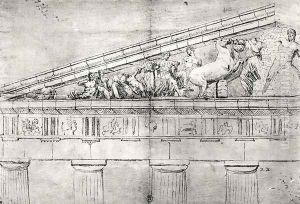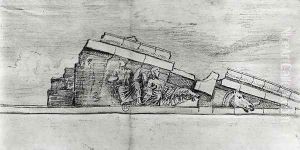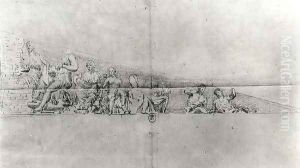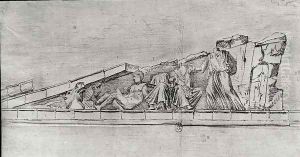Jacques Carrey Paintings
Jacques Carrey was a French painter and draughtsman, best known for his detailed sketches of the Parthenon frieze in Athens. Born in Troyes, France, in 1649, Carrey developed an interest in art at an early age and went on to study drawing. His talent was recognized by prominent individuals of his time, which eventually led to his involvement in a significant historical endeavor.
In 1674, Carrey was employed by the French ambassador to the Ottoman Empire, Charles-Marie-François Olier, Marquis de Nointel, to accompany him on his travels to the Near East as a draughtsman. During this journey, Carrey visited Athens, which was then under Ottoman control, and spent a considerable amount of time drawing the sculptures and reliefs of the Parthenon. His drawings, made in 1674, are of immense historical value because they provide a snapshot of the Parthenon's sculptural decoration some 120 years before Lord Elgin removed many of its marbles to Britain in the early 19th century.
Carrey's sketches are meticulous and detailed, offering critical information about the state of the Parthenon before its subsequent damage and looting. They are one of the earliest systematic efforts to record the art and architecture of ancient Greece, and they provide a basis for understanding the original arrangement and condition of the sculptures. The drawings are particularly important for the study of the Parthenon's metopes, many of which suffered significant damage from a later explosion in 1687 when the Venetians attacked Athens.
After returning to France, Carrey continued his work as an artist, although none of his work achieved the fame of his Parthenon drawings. He served as a painter for various French institutions, including the Gobelins Manufactory, which was a royal factory producing tapestries for the king and his court. Carrey's later life is less documented, but he continued to work as an artist until his death in 1726.
Jacques Carrey's contribution to art history, particularly in the field of archaeological documentation, is noteworthy. His work remains a reference point for scholars studying the Parthenon and classical Greek art. Through his drawings, Carrey inadvertently became an early pioneer in the field of heritage preservation, providing a visual record that has been indispensable in the reconstruction and restoration efforts of the Parthenon's sculptures.



